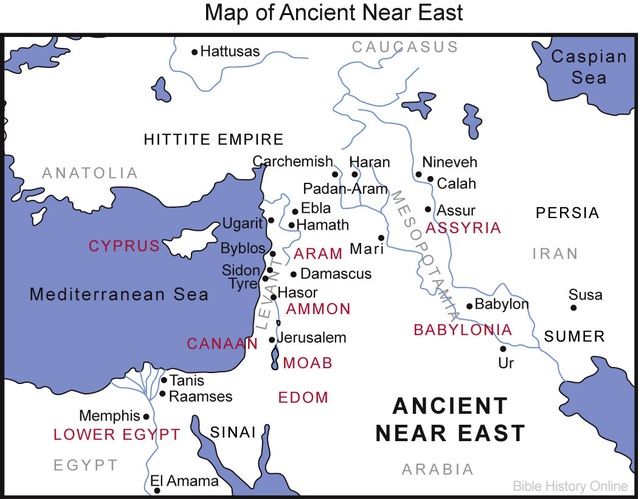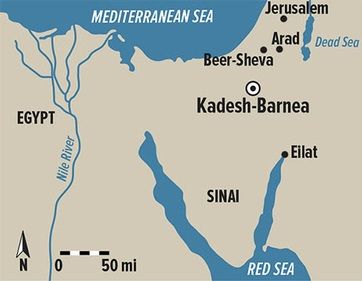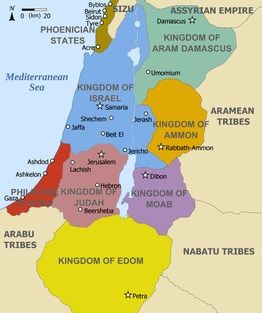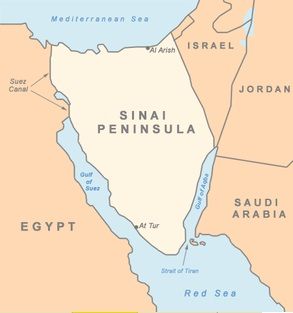


This page was last updated on 28 July, 2019.
Red Sea located




Center north of Edom is The blue spots on the Israel-
the Dead Sea border are the same Red Sea.
1. At the border of Edom
Judg 11:15 And said to him, Thus said Jephthah, Israel took not away the land of Moab, nor the land of the children of Ammon:
Judg 11:16 But when Israel came up from Egypt, and walked through the wilderness to the Red sea, and came to Kadesh;
Judg 11:17 Then Israel sent messengers to the king of Edom, saying, Let me, I pray you, pass through your land: but the king of Edom would not listen thereto…
Egypt → Wilderness (Sinai Peninsula) → Red Sea → Kadesh near Edom.
After they arrived in Kadesh, they talked to the king of Edom. Every scholar and map agrees Kadesh is no way near Egypt. It’s near Israel and Edom.
1Kgs 9:26 And king Solomon made a navy of ships in Eziongeber, which is beside Eloth, on the shore of the Red sea, in the land of Edom.
Edom never was (part of) Egypt.
Solomon’s shipyard was at the northern tip of the Gulf of Aqba. Not in the Suez canal in Egypt. Neither did Solomon built a shipyard in Egypt on one of the rather small lakes and sail around in them.
In fact, Josephus the sea journeys took 3 years.
he commanded to carry out all sorts of merchandise unto the remotest nations, by the sale of which silver and gold were brought to the king, and a great quantity of ivory, and Ethiopians, and apes; and they finished their voyage, going and returning, in three years' timeip took 3 years. That means a sea connected port.
Jewish Antiquities’ book 8 chapter 7
Jer 49:20 Therefore hear the counsel of the LORD, that he has taken against Edom; and his purposes, that he has purposed against the inhabitants of Teman: Surely the least of the flock shall draw them out: surely he shall make their habitations desolate with them.
Jer 49:21 The earth is moved at the noise of their fall, at the cry the noise thereof was heard in the Red sea.
Judg 11:18 Then they went along through the wilderness, and compassed the land of Edom, and the land of Moab, and came by the east side of the land of Moab, and pitched on the other side of Arnon, but came not within the border of Moab: for Arnon was the border of Moab.
Again Edom and the Red Sea are linked. Again Egypt isn’t mentioned at all.
Num 21:4 And they journeyed from mount Hor by the way of the Red sea, to compass the land of Edom: and the soul of the people was much discouraged because of the way.
Edom was roughly triangle shaped and the most narrow and southern point was near the head of the Gulf of Aqba. The border with the Land of Midian.
Edom’s borders were nowhere near the Gulf of Suez. That means the Red Sea is the the Gulf of Aqba.
2. Eloth
1Kgs 9:26 And king Solomon made a navy of ships in Eziongeber, which is beside Eloth, on the shore of the Red sea, in the land of Edom.
- Eloth is located on the shore of the northern tip of the Gulf of Aqba.
- Bible Hub -
Click - Wikpedia, likely present day city of Aqaba -
Click - Bible History, Greek/Roman city Elana on northern tip of Gulf of Aqba -
Click
◊──────────────────◊──────────────────◊
3. The Wilderness
Gen 14:6 And the Horites in their mount Seir, to Elparan, which is by the wilderness.
Exod 13:18 But God led the people about, through the way of the wilderness of the Red sea: and the children of Israel went up harnessed out of the land of Egypt.
Exod 14:3 For Pharaoh will say of the children of Israel, They are entangled in the land, the wilderness has shut them in.
Exod 23:31 And I will set thy border from the Red Sea even to the sea of the Philistines, and from the wilderness to the River. For I will deliver the inhabitants of the land into your hand, and thou shall drive them out before thee.
Midbar is Hebrew for wilderness, but the above verses all use haMidbar.
That’s comparable with theWilderness. ‘Ha’ is definite article that denotes that what follows is something special, something specific. Not just any wilderness. It’s a certain wilderness. That means every wilderness in the above verses in the same one.
That wilderness is close to the Red Sea and close to mt. Seir where the Horites lived. That’s another set of verses the Red Sea is I the Gulf of Aqba.
4. The borders of Israel
Exod 23:31 And I will set thy border from the Red Sea even unto the sea of the Philistines, and from the wilderness unto the River: for I will deliver the inhabitants of the land into your hand: and thou shalt drive them out before thee.
The above verse is describing the borders of Israel. One of those borders in the Red Sea (Yam Suph). That border in the northern tip op the Gulf of Aqba. Not anywhere near the Nile Delta in Egypt.
- South = Red Sea = Northern tip of Gulf of Aqba.
- North = Sea of the Philistines = Mediterranean Sea.
- West = Wilderness. Bordering Sinai Peninsula Egypt.
- East = The river = Euphrates
Check Bible Hub for more location details. -
Israel is not, and never was north of Egypt. So the Red Sea must be the Gulf of Aqba, because that borders Israel.
5. At the border of Edom
Gen 36:1 Now these are the generations of Esau, who is Edom.
Gen 36:8 Thus dwelled Esau in mount Seir: Esau is Edom.
Gen 36:19 These are the sons of Esau, who is Edom, and these are the chiefs.
Edom = Esau
Edom means red
Deut 2:4 And command thou the people, saying, Ye are to pass through the border of your brothers the sons of Esau, who dwell in Seir, and they will be afraid of you. Take ye good heed to yourselves therefore.
Deut 2:8 And when we passed by from our brothers the children of Esau, which dwelled in Seir, through the way of the plain from Elath, and from Eziongaber, we turned and passed by the way of the wilderness of Moab.
Gen 36:8 Thus dwelled Esau in mount Seir: Esau is Edom.
Esau dwelt in mt. Seir
Gen 25:25 And the first came out red, all over like an hairy garment; and they called his name Esau.
Gen 36:8 Thus dwelled Esau in mount Seir: Esau is Edom.
Both Easau and Seir mean ‘hairy’.
There is confusion in the Bible with regard to the relationship of Seir and Edom. They are equated with each other, and are located variously both on the east and west sides of the Aravah. The solution, I believe, lies in remembering that when Edom was conquered by the Babylonians in the sixth century B.C., large numbers of the Edomites were pushed out of their country by the Nabataeans. They crossed the wadi Aravah and settled in southernmost Palestine…. Generally speaking, Edom is mentioned in the Bible with anger and bitterness (I Kings 11:14-
Nelson Glueck,1959, 153-
Sure: Edom = Esua
Sure: Mt. Seir touches the tip of the Gulf of Aqba.
Sure: Edom means red.
Sure: Mt. Seir is lots of red sandstone.
Strongly implied: mt. Seir = Edom = Esau
It’s an accepted fact both Edom and Mt. Seir are close to the tip of the Gulf of Aqba.
6. The end
6a. Wrong translations
8x 5486 -
2x 5487 -
4x 5488 -
24x 5488 -
1x 5489 -
5x 5490 -
5x 5491 -
15x 5492 -
32x 5592 -
20x 5595 -
The above list shows all variations on ‘suph’. The second column is the Strong number.
The 44 black ones clearly have the meaning of some sort of end.
The 15 green ones have the meaning of an end by destruction.
The 32 blue ones, like door, have the meaning of closing (ending) something.
That’s a total of 91 out of 116 entries meaning ‘end’.
The 25 red ones are simply wrong because the Hebrew word for red is Adam. Plus they have nothing in them that even remotely is related to ‘end’.
The remaining 4 orange ones have nothing in them that even remotely is related to ‘end’. The Hebrew word suph doesn’t have any of those meanings. To bypass that obvious fact it’s said it’s an Egyptian loan word. But that’s even problematic in Egyptian.
Scholars concluded the same:
sup must be derived from the Semitic root sup, ‘to come to an end,’ ‘to cease.’ As a substantive sup is attested in the meaning of ‘end,’ ‘edge,’ ‘border’…
Batto 1983, 34
The foregoing discussion strengthens the idea that Red Sea is considered as the “End or Border Sea.” It is quite possible to think of yam suph as such, for the term might come from the root word Pws, which is literally translated as “come to an end.”
William L. Holladay, A Concise Hebrew and Aramaic Lexicon of the Old Testament (1988)
If yam suph has been understood with a broad and general meaning, most likely the translators of the LXX “may well have understood sup to mean, not ‘reeds,’ but ‘end,’ equaling or perhaps reading sop.”
Snaith, 395.
The term yam suph is also translated as the “End or Border Sea.” This alternative translation has been proposed by Copisarow. According to him, when Jacob and his family entered Egypt (Genesis 46) to join his son Joseph there and settled between the Gulf of Suez and the Nile, “Jacob and his family used their Chaldean vocabulary in naming the two terminal features, the Gulf and the bank of the Nile.
So Yam Suph means ‘end sea’, ‘border sea’.
And that is exactly what it is, it marks the most southern border/end of the Promised Land.
6b. ym sph
At the time Exodus was written by Moses, Hebrew had no vowels. So the spelling was YM SPH. Obviously not just for this word, but all parts of the OT that were written in old Hebrew. The vowels were added long after the original authors died. Taking the letters YM SPH as the inspired starting point, all of the five ‘new words’ listed in 6a is correct using grammar rules. Obviously not all are the same as Moses understood it.
In theory several translation could be correct because one not doesn’t always rules out the other. This isn’t a statement, but an explanation. A sea at the end of something could have red reeds that waved in the crossing’s whirlwind.
Eventually vowels were added. If one hold the opinion God inspired the vowels then this section ends here and now. The other option is that oral tradition was uses. For example everyone new it was about the color red. But oral tradition might had it wrong. Or ‘the end’ meant somewhere at the end of Egyptian border, but later was understood as the end of Israeli borders.
There is not a single ultra clear source on this matter. If there was such a source the whole discussion would never have existed in the first place.
And we Christians, most certainly shouldn’t point fingers at the Jews for messing up with oral traditions, because in many cases Christian doctrine became before translations. Something like ‘According to the pope, Israel crossed a lake in Egypt so we need to find a translation of YM SPH that supports the pope’s view.
6c. Four problematic verses
The four verses listed below seem very problematic at first glance because substituting ‘reeds’ with ‘end’ looks very odd.
Exodus 2:3 And when she could hide him no longer she took for him a basket made of bulrushes, and daubed it with bitumen and pitch; and she put the child in it and placed it among the reeds at the river’s brink.
Exodus 2:5 Now the daughter of Pharaoh came down to bathe at the river, and
her maidens walked beside the river; she saw the basket among the reeds and sent her maid to fetch it.
Is it logical that Pharaoh’s daughter bathes in weeds and mud?
The word reeds is translated from can also mean bassin.
Image a swimming pool like area that’s open at the riverside to let water in. A brick basin without mud and weeds.
So Moses’ mother put him in basket in the royal bathing pool, and Pharaoh’s daughter found him there.
Also a far more fool proof way. Putting the basket in the reeds may leave it undetected or the river carries it away.
In the table we see reeds and basin are different words. Suph and Saph.
Maybe they weren’t in the past because the current Hebrew with accents is a MT from 1000 AD.
The LXX can be used as support for that claim. It uses the Greek word Elos which also has the meaning of pool. The ancient Greeks had far more precise words for weeds and papyrus.
Isaiah 19:6 its canals will become foul, and the branches of Egypt's Nile will diminish and dry up, reeds and rushes will rot away.
Replace with ‘banks’ which is an ending.
Jonah 2:5 The waters compassed me about, even to the soul: the depth closed me round about, the weeds were wrapped about my head.
Please note the story of Jonah took place in the Mediterranean Sea. Most certainly no papyrus there. That debunks the whole papyrus, reeds and rushes translation; simply because they don’t grow in a salty sea.
The bottom of the sea in way is the end of the sea. Jonah sank all the way to the bottom.
The corrected verses are as follows:
Exodus 2:3 And when she could hide him no longer she took for him a basket made of bulrushes, and daubed it with bitumen and pitch; and she put the child in it and placed it in the basin at the river’s brink.
Exodus 2:5 Now the daughter of Pharaoh came down to bathe at the river, and her maidens walked beside the river; she saw the basket in the basin and sent her maid to fetch it.
Isaiah 19:6 its canals will become foul, and the branches of Egypt's Nile will diminish and dry up, reeds and [river] banks will rot away.
Jonah 2:5 The waters compassed me about, even to the soul: the depth closed me round about, the [lowest] depths wrapped about my head.
There are several other ways to translate the verses, but my point is that it can be done without using weed, reed or papyrus. And that such a translation is impossible in the Jonah verse because none of those plants grow in the sea.
7. Locust
Yeah, as odd as it may sound, that plague also holds a piece of the location puzzle.
The main key to the mystery is correcting a false doctrinal translation.
Exod 10:19 And the LORD turned a mighty strong west wind, which took away the locusts, and cast them into the Red sea; there remained not one locust in all the coasts of Egypt.
All the red words are false translation that don’t even align with Strong’s.
Below the real translation.
Exod 10:19 And the LORD turned a mighty strong sea wind, which took away the locusts, and drive/blow them Yam Suph; there remained not one locust in all the coasts of Egypt.
The KJV translation states the locust were cast into the Red Sea. But the Hebrew source text is better under stood as blown toward the Red Sea.
So the CL translation is quite accurate except the sea of weeds.
Exod 10:19 Then Yahweh turned an exceedingly steadfast sea wind, and it carried away the locust swarm and blew it toward the Sea of Weeds. Not one locust remained within the entire boundary of Egypt.
If the Red Sea is really one of the small lakes then it’s impossible that wind from a certain direction blows all locust, from all over whole Egypt, into that lake.
Blowing something from a very long border into a much shorter body of water requires the wind to come from multiple directions. Not just from the sea.
The same problem arises if the Red Sea would be the (part of) the Nile Delta.
Not even the long Gulf of Suez is a solution because it ends 90 miles from the coast. So where go the locust swarming in that area? That would also require wind from multiple directions.
But just blowing them toward the Gulf of Aqba solves all problem.
8. Misc
Deut 2:1 Then we turned, and took our journey into the wilderness by the way to the Red Sea, as LORD spoke to me. And we encompassed mount Seir many days.
Seir is an alternative name for Edom or a mountain range in Edom. Click
“…came to the city Midian, which lay upon the Red Sea...”
Josephus Ant. II.xi.1
The Red Sea is near the city Midian. Which is in Midian, which is in modern Saudi Arabia.
Madiam is a city… [that] lies beyond Arabia to the south in the desert of the Saracens, east of the Red sea. From this they are called Madianites, and it is now called Madian” (Eusebius 2003, 70). Saint Jerome (ca 347-
Eusebius
Sinai Peninsula was called ‘Stony Arabia’ in Roman and Byzantine times and was located at the Red Sea.
9. Conclusion
Geography leads to just one conclusion, the Red Sea is (part of) the Gulf of Aqba. Not in or near the Gulf of Suez or Egypt.
When properly translated no reference to plants hinders placing the crossing at the Gulf of Aqba.